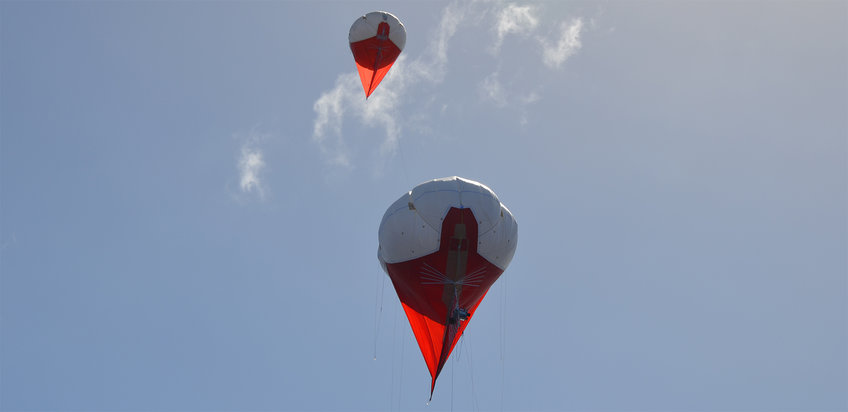
Field campaign IMPACT 2024, Finland
Here, we will give a regular update on the field campaign IMPACT - In situ Measurement of Particles, Atmosphere, Clouds and Turbulence - in Pallas, Finland from May 27 to June 16.
June 12, 2024
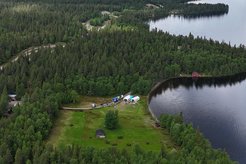
The measurements of the various research groups of the MPI-DS have been taking place on this area for almost 3 weeks now. These also included measurements for more than 20 hours in order to map the physics of the atmosphere over a longer period of time. Thanks to the technical staff on site, the experiments can be individually adapted to the different conditions.
June 10, 2024

The last week of measurements has begun and a local resident of the region also keeps the scientists company from time to time. Clouds with occasional showers alternate with clear blue skies several times a day - providing ideal conditions for the various measurements. Both the Windarts and the balloon-based sensors have already collected very promising data that is waiting to be analyzed back in Göttingen.
June 7, 2024
Not only scientific measuring instruments are attached to the CloudKite: also a camera monitors the surrounding area. This video shows the landscape shortly before the CloudKite raised further up into the clouds. According to the scientists on site, the weather conditions are currently very good.
June 5, 2024
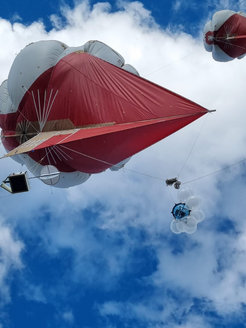
The CloudKite is used to lift the control unit with balloons attached to it. The balloons in turn are attached to small sensors which are used to represent atmospheric pollutants. Upon a defined signal to the control unit, all balloons are released simultaneously and collect data from that area. This way, the scientists aim to improve predictions how pollutants or other particles are distributed in the atmosphere.
June 3, 2024
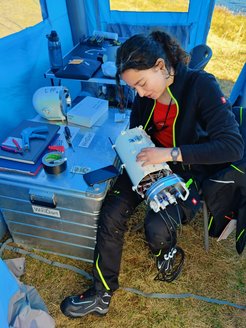
The Windarts are being prepared for take-off. Here, Venecia Chávez Medina is replacing one of their GPS antennas. These are used to determine the exact position of the instruments so that the collected data can be assigned to a precise position. The scientists are particularly interested in the boundary layer: by observing the peripheral areas of clouds, they hope to gain new insights into their life cycle.
May 31, 2024
The two CloudKites are in the air! The maiden flight recently took place over the Finnish taiga. The two balloons were firmly anchored to the ground so that they can fly even in stronger winds. The weather forecast for the next few days is cloudy, but most likely, measurements can continue as planned. The Windarts will also be put into operation shortly.
May 28, 2024
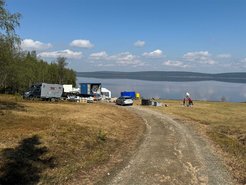
After several days of travel, the transport has arrived safely in Finland. Several other scientists by now have also joined the team. Now everyone is starting to set up the equipment for the measurements over the next few weeks. Until a few days ago, the area was still covered in a layer of snow - fortunately, spring has now arrived also in Lapland. With temperatures sometimes above 20 degrees Celsius and only occasional rainfall, the researchers are working hand in hand to start the measurements as quickly as possible.
May 27, 2024

You may be wondering what is in these containers that are currently being shipped to Finland. One of the measuring devices is the so-called 'HoloTrack', which is used to measure cloud droplets in the clouds. A green laser is emitted between two arms of the measuring box, with which tiny droplets can be detected and tracked. This is the latest MPIDS imaging system which, unlike previous holography systems, also measures the velocity of each droplet detected. With the help of the CloudKite, the entire setup is lifted high into the clouds.
May 24, 2024
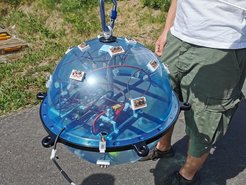
One of the projects aims to test a new sensor system which is composed of many atmospheric tracers, raised up with balloons. At a height of approximately 1,000 meters, the balloons will be releases allowing the sensors to collect information on atmospheric parameters. To release all sensors at the same time, the 24 balloons are tied to a special sphere, shown in the picture. Up in the air, a radio signal will release the balloons and distribute the sensors, provided by SparvEmbedded, in a controlled way.
Together with the Fraunhofer Institute for Integrated Circuits in Erlangen, the MPI-DS scientists will use these measurement data to develop a sensor-system which could be used to monitor the distribution of pollutants or other particles in the atmosphere.
May 23, 2024
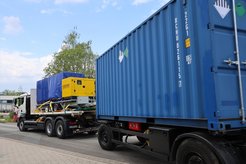
The first MPI-DS scientists set off for Finland today with several fully loaded vehicles. Almost 3,000 kilometers of travel lie ahead of them, including a ferry crossing. In the next few days, their colleagues will also arrive and then meet up with them in the area around Pallas. We wish them a safe journey!
May 21, 2024
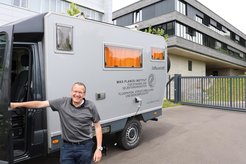
In a few days, scientists from the MPI-DS will set off for Finland to spend several weeks studying particles, atmosphere, clouds and turbulence. Together with his team, Eberhard Bodenschatz, head of the field campaign and director at the MPI-DS, is making final preparations.
May 13, 2024
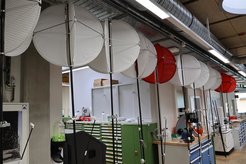
The eleven Windarts are assembled in the workshop. Like oversized darts, they will be attached to the rope leading up to the cloud kite. Up there, they will measure various atmospheric parameters. Thanks to their construction, the darts remain stable and can be held in position even in slightly bad weather.
May 8, 2024

Mohsen Bagheri is one of the coordinators of the field campaign. During this project, also the Max Planck Cloud Kite (MPCK) will fly through the clouds at an altitude of up to 2 kilometers. There, advanced imaging sensors will measure cloud droplets and atmospheric turbulence. This way the scientists will gain insights on cloud formation and lifetime.
May 7, 2024
The Holo-Track is also used in Finland to study cloud droplets. Birte Thiede makes the final preparations and prepares a component for the measuring apparatus. A laser and a camera are used to measure the position, size and movement of the droplets in the clouds.
May 7, 2024
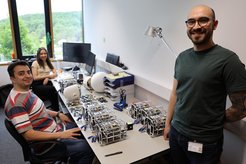
Venecia Chávez Medina, Hossein Khodamoradi and Cristobal Nieto González are working on the brains of the eleven windarts. Those will be attached to the rope of the Cloudkite are rise up to 2km high. The windarts will measure the main atmospheric quantities such as temperature, pressure, wind velocity in 3 directions as well as the CO2 concentration.
May 6, 2024
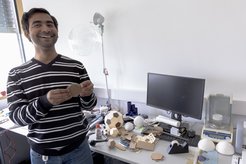
Plant seeds, volcanic ash or cloud ice particles occur in different forms and are distributed in the atmosphere in different ways that cannot be reproduced in the laboratory. To understand the shape-dependent fall behavior, Taraprasad Bhowmick crafts various objects, which will be dropped from a height of 1 to 2 kilometers using a balloon. The objects have the same mass and density, but different shapes and sizes. The idea is to use specially installed sensors to collect data on the flight and fall characteristics of the various objects for further measurements.
May 2, 2024
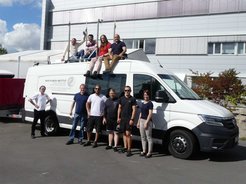
Preparations are in full swing. While the cloud kites are being prepared and packed for the trip, the final measuring devices are being checked to ensure that everything works smoothly on site. At the end of May, the scientists set off for the test site around 2,500 km away in a total of three vehicles.













